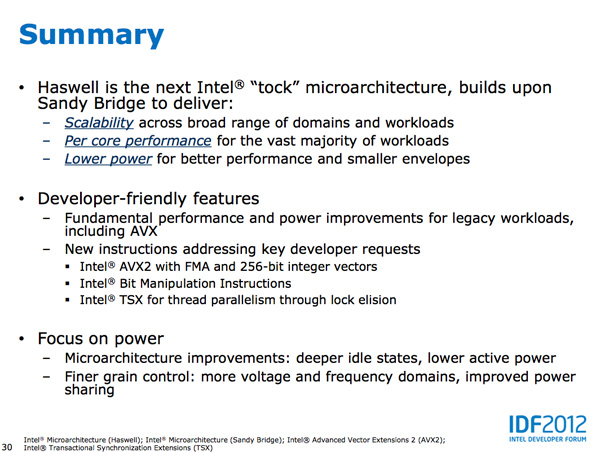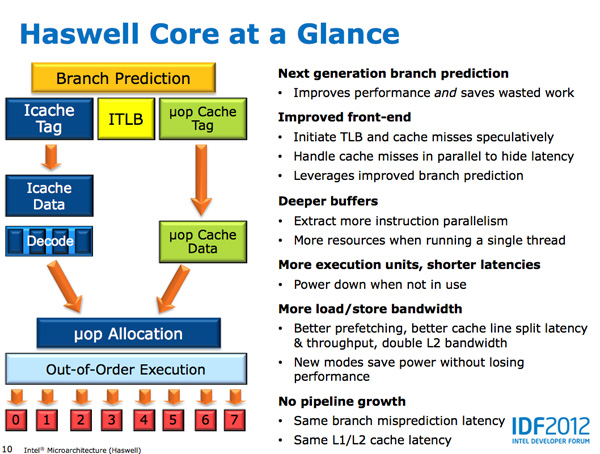Intel's Haswell Architecture Analyzed: Building a New PC and a New Intel
by Anand Lal Shimpi on October 5, 2012 2:45 AM ESTFinal Words
After the show many seemed to feel like Intel short changed us at this year's IDF when it came to architecture details and disclosures. The problem is perspective. Shortly after I returned home from the show I heard an interesting comparison: Intel detailed quite a bit about an architecture that wouldn't be shipping for another 9 months, while Apple wouldn't say a thing about an SoC that was shipping in a week. That's probably an extreme comparison given that Apple has no motivation to share details about A6 (yet), but even if you compare Intel's openness at IDF to the rest of the chip makers we cover - there's a striking contrast. We'll always want more from Intel at IDF, but I do hope that we won't see a retreat as the rest of the industry seems to be ok with non-disclosure as standard practice.
There are three conclusions that have to be made when it comes to Haswell: its CPU architecture, its platform architecture and what it means for Intel's future. Two of the three look good from my perspective. The third one is not so clear.
Intel's execution has been relentless since 2006. That's over half a decade of iterating architectures, as promised, roughly once a year. Little, big, little, big, process, architecture, process, architecture, over and over again. It's a combination of great execution on the architecture side combined with great enabling by Intel's manufacturing group. Haswell will continue to carry the torch in this regard.
The Haswell micro-architecture focuses primarily on widening the execution engine that has been with us, moderately changed, for the past several years. Increasing data structures and buffers inside the processor helps to feed the beast, as does a tremendous increase in cache bandwidth. Support for new instructions in AVX2 via Intel's TSX should also pave the way for some big performance gains going forward. Power consumption is also a serious target for Haswell given that it must improve performance without dramatically increasing TDP. There will be slight TDP increases across the board for traditional form factors, while ultra portables will obviously shift to lower TDPs. Idle power drops while active power should obviously be higher than Ivy Bridge.
You can expect CPU performance to increase by around 5 - 15% at the same clock speed as Ivy Bridge. Graphics performance will see a far larger boost (at least in the high-end GT3 configuration) of up to 2x vs. Intel's HD 4000 in a standard voltage/TDP system. GPU performance in Ultrabooks will increase by up to 30% over HD 4000.
As a desktop or notebook microprocessor, Haswell looks very good. The architecture remains focused and delivers a sensible set of improvements over its predecessor.
As a platform, Haswell looks awesome. While the standard Haswell parts won't drive platform power down considerably, the new Haswell U/ULT parts will. Intel is promising a greater than 20x reduction in platform idle power and it's planning on delivering it by focusing its power reduction efforts beyond Intel manufactured components. Haswell Ultrabooks and tablets will have Intel's influence in many (most?) of the components placed on the motherboard. And honestly, this is something Intel (or one of its OEMs) should have done long ago. Driving down platform power is a problem that extends beyond the CPU or chipset, and it's one that requires a holistic solution. With Haswell, Intel appears committed to delivering that solution. It's not for purely altruistic reasons, but for the survival of the PC. I remember talking to Vivek about an iPad as a notebook replacement piece he was doing a while back. The biggest advantage the iPad offered over a notebook in his eyes? Battery life. Even for light workloads today's most power efficient ultraportable notebooks can't touch a good ARM based tablet. Haswell U/ULT's significant reduction in platform power is intended to fix that. I don't know that we'll get to 10+ hours of battery life on a single charge, but we should be much better off than we are today.
Connected standby is coming to PCs and it's a truly necessary addition. Haswell's support of active idle states (S0ix) is a game changer for the way portable PCs work. The bigger concern is whether or not the OEMs and ISVs will do their best to really take advantage of what Haswell offers. I know one will, but will the rest? Intel's increasingly hands on approach to OEM relations seems to be its way of ensuring we'll see Haswell live up to its potential.
Haswell, on paper, appears to do everything Intel needs to evolve the mobile PC platform. What's unclear is how far down the TDP stack Intel will be able to take the architecture. Intel seems to believe that TDPs below 8W are attainable, but it's too early to tell just how low Haswell can go. It's more than likely that Intel knows and just doesn't want to share at this point. I don't believe we'll see fanless Haswell designs, but Broadwell is another story entirely.
There's no diagram for where we go from here. Intel originally claimed that Atom would service an expanded range of TDPs all the way up to 10W. With Core architectures dipping below 10W, I do wonder if that slide was a bit of misdirection. I wonder if, instead, the real goal is to drive Core well into Atom territory. If Intel wants to solve its ARM problem, that would appear to be a very good solution.












245 Comments
View All Comments
Peanutsrevenge - Friday, October 5, 2012 - link
What the hell are you guys bitching about?Of course the iPhone articles are going to be longer and more numerous than GS3 articles.
iPhone releases come with new iOS releases and have their own eco-system.
Android phone releases use a common OS across them and therefore much of what's in one article doesn't need repeating in another.
Anand liking Apple is not our problem, I can see why people like them (not so much Anand) and that's fine, personally I dislike them (hate was originally typed, but was edited due to being incorrect), but still respect them and respect people who purchase their products (and pay for their litigation).
An entire page of comments talking about how Anand isn't allowed to like or talk about Apple products because you guys don't like is ridiculous, they're a PC company and should exist on a PC website.
Grow up.
Kepe - Friday, October 5, 2012 - link
Sure, but I'm talking about dedicating entire, long articles to such things as the iPhone display or why it doesn't have a certain feature and so on. The SGS III has a very interesting display, too. Still it didn't get nearly as much attention. Of course Anand is allowed to talk about Apple products. What I want, though, is Anand(tech) to be as thorough in reviewing other products, too, or then stop making those huge articles only about Apple products. Because that is biased.In the Macbook Pro Retina article Anand talked about the cooling system and the fan blades for one page. When I read any other laptop review on Anandtech, cooling is briefly described in a sentence or two.
Dedicating so much attention to just one company's products makes it look like Anandtech is biased. And that is not good.
Magik_Breezy - Sunday, October 14, 2012 - link
Hopefully because of these comments they'll finally see what we want, not some Apple crap. Good engineering stupid managementSpunjji - Thursday, October 18, 2012 - link
Nailed it.vFunct - Saturday, October 6, 2012 - link
Android products would get more coverage if they bothered to do any engineering on them. Since they don't push the technology the way Apple does, they don't need a more in-depth review.StevoLincolnite - Saturday, October 6, 2012 - link
You're kidding right? Hardware wise Apple has always been behind the curve compared to the competition in every facet of it's product line-ups or very quickly beaten.lmcd - Saturday, October 6, 2012 - link
Umm, I would disagree there. Apple has always been ahead of the curve in GPUs and this is the FIRST TIME SINCE BEFORE THE A-SERIES that Apple has had a GPU without an overwhelming lead on the competition for more than half a year.*While GPU selection isn't always huge, it's one of the biggest points of differentiation in mobile chips, along with power use.
*excluding the A4 if you count from when it was first in a phone as opposed to in a tablet.
Magik_Breezy - Sunday, October 14, 2012 - link
The last time I played a game on my phone was about 8 months ago and I'm 15! To say that Apple pushes their hardware is naive as it gets.The Galaxy S III was the best purchase Ive made, even my mum doesn't like my iPhone 4.
vFunct - Sunday, October 7, 2012 - link
Yes, Apple products are always ahead of compromised Android products.Android devices are badly engineered, like incorporating LTE when the battery can't handle it, for example. Apple doesn't compromise on their design.
Kepe - Monday, October 8, 2012 - link
How much does Apple pay you for a comment praising them?